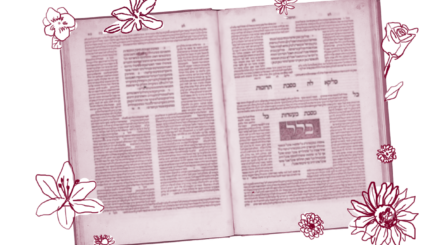On today’s daf, we continue our discussion of yayin nesech, wine touched by a non-Jew that is suspected of being used in idolatrous libations. Today, the rabbis focus on whether the non-Jew’s touch needs to be intentional. The Talmud tells a story about an accidental touch. Here’s the story you’ll find in your Talmud:
There was a certain incident in Biram that occurred as follows: There was a certain gentile who was climbing a palm tree and he brought down with him a palm branch. While he was descending from the tree he unintentionally touched some wine with the tip of the palm branch. Rav permitted the owners to sell the wine to gentiles.
Here a non-Jew climbing down a palm tree with a palm branch in his hands accidentally slips and touches kosher wine with the tip of the branch. The touch is clearly unintentional, so does the wine now have the status of yayin nesech? Rav’s answer occupies a middle ground: Jews cannot drink the wine, but they can derive benefit from it by selling it to non-Jews.
Two rabbis next interrogate Rav’s position. Are Jews really allowed to derive benefit from wine that has been touched by a non-Jew, even by accident?
Rav Kahana and Rav Asi said to Rav: But wasn’t it you, master, who said: A baby who is one day old, he renders it wine used for a libation?
If I know anything about newborns, it’s that they can’t move their limbs intentionally — much less pour out libations to foreign gods. That, and they smell amazing. So if a newborn accidentally flails an arm and touches an open bottle of kosher wine, it would be reasonable to say that the wine has not been offered to a foreign god. Yet Rav’s students heard their teacher characterize it as yayin nesech! Why would the infant’s touch be even more damaging than the palm frond accidentally brushed over wine by the adult tree climber?
Rav said to them: Say that I said for drinking. Did I say to benefit?
Rav explains that he is, in fact, consistent. In both cases, he considered the wine now yayin nesech when it comes to Jews being able to drink it. But unlike most yayin nesech, he permits Jews to sell this wine to non-Jews and benefit financially from it. So far so good. Except that, even if the cases are both about intention, there’s another fundamental difference between the two. The baby actually touches the wine, while the tree climber never actually does! Instead, in the version of the Talmud we read today, the wine is touched by the tip of a palm branch.
Based on my experiences with a lulav, the tree climber is at least two feet away. But curiously, the rabbis of the Talmud never address this difference. Instead, the discussion moves on to the age at which a minor can be considered to intentionally dedicate wine as a libation.
The extant manuscripts all contain the phrase “with the tip of the palm branch.” And indeed, the medieval French Tosafists read this story to derive extensive laws about how non-Jews touching kosher wine with another object render it yayin nesech. But Rabbi Isaac Alfasi, an 11th-century North African rabbi, suggests that this phrase is a scribal error, and that the man touched the wine directly with his hand. Maimonides concurs with this reading. This is a case where none of the extant manuscripts agree with this reading, but it certainly makes more sense in the context of the Talmud’s discussion.
Today’s daf then leaves us with even more questions than we originally realized. Not just questions about intention and the age of intention, but also questions about how and when errors are introduced into texts by scribes, how we even know what the actual text of the Talmud really is and how different sages throughout our history can read the same version of our important texts and come to different conclusions.
Read all of Avodah Zarah 57 on Sefaria.
This piece originally appeared in a My Jewish Learning Daf Yomi email newsletter sent on August 14, 2025. If you are interested in receiving the newsletter, sign up here.
With your help, My Jewish Learning can provide endless opportunities for learning, connection and discovery.



